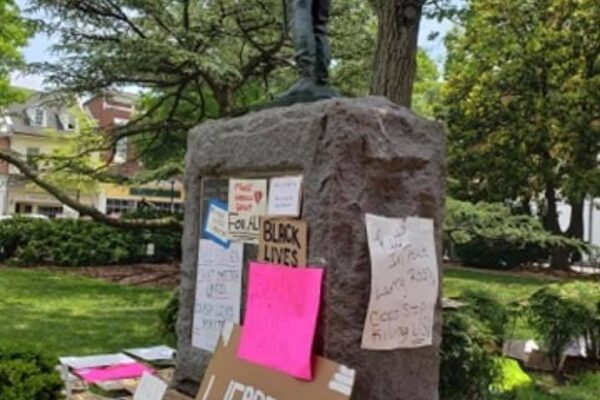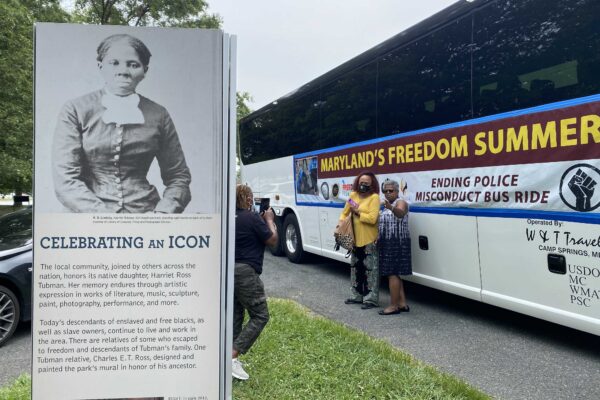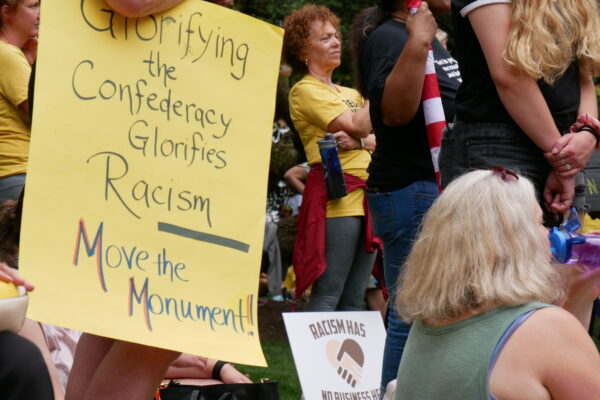Plaintiffs Make Clear the “Talbot Boys” is a Monument to White Supremacy with No Place on the Public Square
EASTON, MD – The Maryland Office of the Public Defender, the Talbot County Branch of the National Association for the Advancement of Colored People (NAACP), attorney Kisha Petticolas, and community activist Richard M. Potter today joined with the American Civil Liberties Union of Maryland and the Washington, D.C. law firm Crowell & Moring LLP to file suit in federal district court in Baltimore challenging as racist and illegal Talbot County’s placement and retention of a Confederate monument on the grounds of the county courthouse in Easton — the last on public land in Maryland.
“By this action,” the lawsuit begins, “Plaintiffs ask the Court to rule that a statue glorifying the Confederacy on the lawn of the courthouse in Talbot County, Maryland, is both unconstitutional and illegal under federal law and the laws of the State of Maryland.”
It goes on:
That any government in the United States would continue to maintain the symbolism of white supremacy and promote a legacy of racial subjugation should shock the conscience. That Talbot County does so on a courthouse lawn—a place of prominence that holds itself out as the seat of justice in the county; a place that county citizens pay for and maintain with tax dollars, including the tax dollars of its Black citizens who are overtly denigrated and humiliated by the statue—only compounds the unconscionability of the statue and illuminates its illegality. The so-called ‘Talbot Boys’ statue—an homage to traitors to the United States and to the State of Maryland, who fought to sustain the enslavement and subjugation of Black people and to tear apart the Union—cannot remain on government property consistent with the core promise of the Fourteenth Amendment to all Americans: equality under the law.”
Plaintiff Kisha Petticolas, a Black lawyer who has worked in the Easton Office of the Maryland Public Defender for the last decade, explained the effects she feels from a Confederate statue situated at the place she works and seeks justice for her clients:
“Every day, I have to walk past that statue to get to work. It’s an unavoidable and painfully constant reminder of a time when white people fought for Black people to stay enslaved. It is a violent, hateful legacy that white supremacists fought to preserve. How can we keep this Confederate monument erected without promoting the same legacy of white supremacy? It cannot be done. How can any Black Marylanders expect justice at a courthouse that holds up a racist symbol on a pedestal for all to see?”
The NAACP and a growing number of community activists have been advocating for years for removal of the monument, arguing it promotes a legacy of racism, celebrates traitors to the union, and is a symbol of white supremacy that is intolerable at the entryway to a public courthouse. The Talbot NAACP first asked the County to remove the statue in the summer of 2015, following the murders by a white supremacist of nine Black churchgoers in Charleston, S.C. The Council considered the request, but unanimously elected to retain the statue in 2016. Since then, requests for reconsideration have recurred periodically, as racist incidents connected to Confederate imagery continued, and as states and other local governments across the country and Maryland removed their own pro-Confederate monuments, leaving Talbot County alone in Maryland in retaining its monument.
Protests and discussions reached a fever pitch last summer, following the police killing of George Floyd in Minneapolis. In June, the Talbot Council President, Corey Pack, who is Black and had voted to retain the monument in 2015, spoke out forcefully in favor of removal, saying he had had a change of heart. Pack introduced a resolution to remove the statue, drawing enormous public support for removal over the course of the summer. But in August, three members of the Council overrode the votes of Pack and Councilman Pete Lesher, and voted yet again to retain the statue, notwithstanding public opposition. Since that time, the three Council members opposed to removal have refused to convene a community meeting with the NAACP and community faith leaders to discuss the issue further, seeking to shut down debate. As a result, the NAACP and other plaintiffs decided their last resort to push the matter forward was litigation.
Said Richard Potter, who joins the lawsuit as an individual plaintiff and serves as President of the Talbot County NAACP, has fought for removal of the statue since 2015:
“We are asking for the immediate removal of this white supremacist statue. Confederate monuments have no place in modern day America. We are moving forward towards a State and Nation that finally achieves the inclusive manifestation of the same ideals in the Declaration of Independence. That means seeking justice and equality for all Americans. It would be a travesty to keep honoring a past that is riddled with racism and symbolizes white supremacy. Let’s get rid of Confederate monument in Talbot County.”
The lawsuit contends that Talbot County’s homage to white supremacists and traitors to the United States and to the State of Maryland cannot remain on government property because it is not consistent with the core promise of the Fourteenth Amendment: equality to all Americans under the law.
Dana Vickers Shelley, Executive Director of the ACLU of Maryland, said:
“This final vestige of the traitorous confederacy has got to go. At long last, Maryland is finally moving away from symbols like this, including discarding the Maryland State song, an outdated homage to white supremacy. The Talbot Confederate statue stands on the same spot a slave auction block once stood, not far from the local “Hanging Tree,” where Black people were lynched. Like most Confederate monuments, it was built 50 years after the Civil War, during the height of the Jim Crow era when such symbols were erected to put fear into formerly enslaved people, and now it is beyond time for this racist symbol of violence and oppression to be removed.”
State Public Defender Paul DeWolfe, who heads Maryland’s statewide public defense agency, said the Office of the Public Defender felt compelled to join the challenge to represent the interests of both its clients and its Black staff in Talbot County. “How can our public defenders be expected to work and to provide ‘Justice, Fairness, and Dignity for all’, consistent with our mission, in the shadow of a courthouse statue glorifying white supremacy?” asked DeWolfe.
As the lawsuit notes, white supremacists often brandish the Confederate flag in modern-day racist attacks. In addition to the racist murders at the Emanuel African Methodist Episcopal Church in Charleston, and the 2017 Charlottesville attack – both associated with the Confederate flag – just this year white supremacists raising Confederate flags staged an insurrection, illegally storming and laying siege to the United States Capitol building during the counting of the Electoral College votes to confirm the winner of the 2020 Presidential Election. Those white supremacists caused the deaths of several members of the Capitol Police, who tried to defend the Congress and Capitol.
Dan Wolff, an attorney with Crowell & Moring, stressed the blatant incongruity between what, on the one hand, the Equal Protection Clause of the Fourteenth Amendment guarantees to Black citizens and, on the other hand, how Talbot County treats Black citizens by dint of maintaining a statue glorifying white supremacy on the courthouse grounds:
“The Talbot Boys statue stands at the entrance to the courthouse—a place that serves a central role in ensuring fairness and delivering justice in our system of laws. With its Confederate soldier atop the pedestal staring down at all who enter the courthouse, it is an affront to all citizens of conscience, Black citizens especially. It was erected to intimidate and the county’s insistence that it remain only doubles down on that message of intimidation. The Confederacy was composed of traitors to the country and defenders of white supremacy, and monuments glorifying its racist cause cannot be maintained by governments consistent with the U.S. Constitution and other laws.”
“Officials from Talbot County would do well to learn, as Alexander Hamilton told us, ‘History has its eyes on you,’” ACLU of Maryland Legal Director Deborah Jeon added. “The time is now to do the right thing, at long last, and take down this racist monument.”
The Maryland Office of the Public Defender, the National Association for the Advancement of Colored People, Kisha Petticolas, and Richard M. Potter are represented by attorneys Daniel W. Wolff, David Ervin, Kelly H. Hibbert, Eric Ashby, Suzanne Trivette, and Tiffanie McDowell of Crowell & Moring LLP, and Deborah A. Jeon, Legal Director of the ACLU of Maryland.
###
Stay Informed
Sign up to be the first to hear about how to take action.
By completing this form, I agree to receive occasional emails per the terms of the ACLU’s privacy statement.
By completing this form, I agree to receive occasional emails per the terms of the ACLU’s privacy statement.




